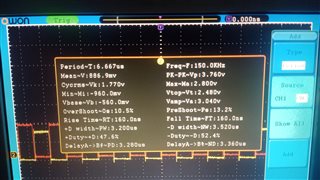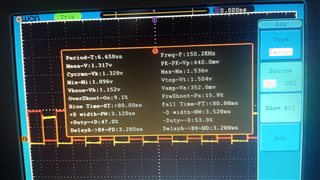- Ask a related questionWhat is a related question?A related question is a question created from another question. When the related question is created, it will be automatically linked to the original question.
This thread has been locked.
If you have a related question, please click the "Ask a related question" button in the top right corner. The newly created question will be automatically linked to this question.
Tool/software:
Hi,
I'm trying to generate 2 inverted PWMs, each pwm has 50% duty cycle and there is a dead band of 200ns between the signals, the Dead band is generated flawlessly
But My problem ,s I can't get precise duty cycle values it varies between 47% - 53% as seen in the oscilloscope pic. below
So how could i achieve precise duty cycle(exactly 50%) while maintaining the dead band (Code is )
#include "f28x_Project.h"
__interrupt void epwm1_ISR(void);
__interrupt void epwm2_ISR(void);
//PWM Period= (2×Desired Frequency) / System Clock
Uint16 pwm_period = 333; // 150 kHz frequency with 100 MHz clock
Uint16 duty_cycle_cmpa = 166; // 50% duty cycle (TBPRD/2)
Uint16 deadband_value = 20; // 200 ns deadband (20 clock cycles)
void main(void)
{
// Initialize system
InitSysCtrl();
// Disable interrupts
DINT;
// Clear interrupts
IER = 0x0000;
IFR = 0x0000;
// Initialize peripherals
InitPieCtrl();
// Initialize PIE vector table
InitPieVectTable();
// Assign our ISR addresses to the elements in vector table
EALLOW;
PieVectTable.EPWM1_INT = &epwm1_ISR;
PieVectTable.EPWM2_INT = &epwm2_ISR;
EDIS;
// Enable ePWM1 and ePWM2 clocks
EALLOW;
CpuSysRegs.PCLKCR2.bit.EPWM1 = 1;
CpuSysRegs.PCLKCR2.bit.EPWM2 = 1;
EDIS;
// Configure ePWM1
EPwm1Regs.TBPRD = pwm_period; // Set 150 kHz period
EPwm1Regs.TBCTL.bit.CTRMODE = 2; // Up-down count mode
EPwm1Regs.TBCTL.bit.HSPCLKDIV = 0; // No high-speed clock divider
EPwm1Regs.TBCTL.bit.CLKDIV = 0; // No clock divider
EPwm1Regs.CMPA.bit.CMPA = pwm_period/2; // 50% duty cycle
// Configure Action Qualifier for ePWM1 A and B
EPwm1Regs.AQCTLA.bit.CAU = AQ_CLEAR; // Clear PWM on CMPA up count
EPwm1Regs.AQCTLA.bit.CAD = AQ_SET; // Set PWM on CMPA down count
EPwm1Regs.AQCTLB.bit.CAU = AQ_CLEAR; // Set PWM on CMPA up count
EPwm1Regs.AQCTLB.bit.CAD = AQ_SET; // Clear PWM on CMPA down count
// Dead band configuration for ePWM1
EPwm1Regs.DBCTL.bit.IN_MODE = 1; // EPWMxA as source for both rising and falling edges
EPwm1Regs.DBCTL.bit.POLSEL = 2; // Active low complementary mode
EPwm1Regs.DBCTL.bit.OUT_MODE = 3; // Deadband fully enabled
EPwm1Regs.DBRED.bit.DBRED = deadband_value; // Rising edge delay
EPwm1Regs.DBFED.bit.DBFED = deadband_value; // Falling edge delay
// Configure ePWM2 similarly
EPwm2Regs.TBPRD = pwm_period;
EPwm2Regs.TBCTL.bit.CTRMODE = 2; // Up-down count mode
EPwm2Regs.TBCTL.bit.HSPCLKDIV = 0;
EPwm2Regs.TBCTL.bit.CLKDIV = 0;
EPwm2Regs.CMPA.bit.CMPA = pwm_period/2; // 50% duty cycle
EPwm2Regs.AQCTLA.bit.CAU = AQ_CLEAR;
EPwm2Regs.AQCTLA.bit.CAD = AQ_SET;
EPwm2Regs.AQCTLB.bit.CAU = AQ_CLEAR;
EPwm2Regs.AQCTLB.bit.CAD = AQ_SET;
// Dead band configuration for ePWM2
EPwm2Regs.DBCTL.bit.IN_MODE = 1;
EPwm2Regs.DBCTL.bit.POLSEL = 2;
EPwm2Regs.DBCTL.bit.OUT_MODE = 3;
EPwm2Regs.DBRED.bit.DBRED = deadband_value;
EPwm2Regs.DBFED.bit.DBFED = deadband_value;
// Enable PIE interrupts for ePWM1 and ePWM2
PieCtrlRegs.PIEIER3.bit.INTx1 = 1;
PieCtrlRegs.PIEIER3.bit.INTx2 = 1;
// Enable group interrupts in IER
IER |= M_INT3;
// Enable global interrupts
EINT;
// Setup GPIO pins for ePWM1 and ePWM2
EALLOW;
GpioCtrlRegs.GPAMUX1.bit.GPIO0 = 1; // ePWM1A
GpioCtrlRegs.GPAMUX1.bit.GPIO1 = 1; // ePWM1B
GpioCtrlRegs.GPAMUX1.bit.GPIO2 = 1; // ePWM2A
GpioCtrlRegs.GPAMUX1.bit.GPIO3 = 1; // ePWM2B
EDIS;
// Infinite loop
for (;;);
}
// ISR for ePWM1
__interrupt void epwm1_ISR(void)
{
// Clear interrupt flag
EPwm1Regs.ETCLR.bit.INT = 1;
// Acknowledge interrupt in PIE
PieCtrlRegs.PIEACK.bit.ACK3 = 1;
}
// ISR for ePWM2
__interrupt void epwm2_ISR(void)
{
// Clear interrupt flag
EPwm2Regs.ETCLR.bit.INT = 1;
// Acknowledge interrupt in PIE
PieCtrlRegs.PIEACK.bit.ACK3 = 1;
}


Hi Haystack,
In order to generate exactly 50% duty on both ePWMA and ePMWB and have dead band it may be easier to generate without using the dead band submodule.
Dead Band module will apply the rising edge or falling edge delay on the PWM outputs or it can apply both to a single signal. This will shrink or increase your duty of at least one of your PWM signal.
Could you instead generate CMPA values that have the calculated dead band in them? Since you're using CMPAU and CMPAD AQ events you can use these for ePWMA. Then invert the AQCTLB settings to generate your complimentary ePWMB signal with CMPBU and CMPBD AQ events.
Best regards,
Ryan Ma